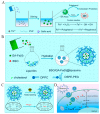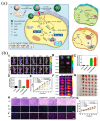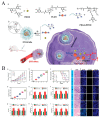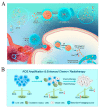Recent Advances of Fe(III)/Fe(II)-MPNs in Biomedical Applications
- PMID: 37242566
- PMCID: PMC10223096
- DOI: 10.3390/pharmaceutics15051323
Recent Advances of Fe(III)/Fe(II)-MPNs in Biomedical Applications
Abstract
Metal-phenolic networks (MPNs) are a new type of nanomaterial self-assembled by metal ions and polyphenols that have been developed rapidly in recent decades. They have been widely investigated, in the biomedical field, for their environmental friendliness, high quality, good bio-adhesiveness, and bio-compatibility, playing a crucial role in tumor treatment. As the most common subclass of the MPNs family, Fe-based MPNs are most frequently used in chemodynamic therapy (CDT) and phototherapy (PTT), where they are often used as nanocoatings to encapsulate drugs, as well as good Fenton reagents and photosensitizers to improve tumor therapeutic efficiency substantially. In this review, strategies for preparing various types of Fe-based MPNs are first summarized. We highlight the advantages of Fe-based MPNs under the different species of polyphenol ligands for their application in tumor treatments. Finally, some current problems and challenges of Fe-based MPNs, along with a future perspective on biomedical applications, are discussed.
Keywords: CDT; Fe-based MPN; Fenton reaction; PTT; tumor treatment.
Conflict of interest statement
The authors declare no conflict of interest.
Figures





















Similar articles
-
Recent advances of copper-based metal phenolic networks in biomedical applications.Colloids Surf B Biointerfaces. 2024 Dec;244:114163. doi: 10.1016/j.colsurfb.2024.114163. Epub 2024 Aug 14. Colloids Surf B Biointerfaces. 2024. PMID: 39154599 Review.
-
Metal-phenolic networks for cancer theranostics.Biomater Sci. 2021 Apr 21;9(8):2825-2849. doi: 10.1039/d0bm02064h. Epub 2021 Mar 10. Biomater Sci. 2021. PMID: 33688863 Review.
-
Employing single valency polyphenol to prepare metal-phenolic network antitumor reagents through FeOOH assistance.J Control Release. 2023 Jun;358:612-625. doi: 10.1016/j.jconrel.2023.05.020. Epub 2023 May 19. J Control Release. 2023. PMID: 37196899
-
Fe(III)-Naphthazarin Metal-Phenolic Networks for Glutathione-Depleting Enhanced Ferroptosis-Apoptosis Combined Cancer Therapy.Small. 2023 May;19(19):e2207825. doi: 10.1002/smll.202207825. Epub 2023 Feb 11. Small. 2023. PMID: 36772903
-
Polydopamine nanoparticles coated with a metal-polyphenol network for enhanced photothermal/chemodynamic cancer combination therapy.Int J Biol Macromol. 2023 May 31;238:124088. doi: 10.1016/j.ijbiomac.2023.124088. Epub 2023 Mar 21. Int J Biol Macromol. 2023. PMID: 36948332
Cited by
-
Advances in multifunctional metal-organic framework (MOF)-based nanoplatforms for cancer starvation therapy.Expert Rev Mol Med. 2024 Oct 14;26:e27. doi: 10.1017/erm.2024.28. Expert Rev Mol Med. 2024. PMID: 39397711 Free PMC article. Review.
-
Synthesis and Applications of Hybrid Polymer Networks Based on Renewable Natural Macromolecules.Molecules. 2023 Aug 12;28(16):6030. doi: 10.3390/molecules28166030. Molecules. 2023. PMID: 37630282 Free PMC article. Review.
-
Iron-Gallic Acid Peptide Nanoparticles as a Versatile Platform for Cellular Delivery with Synergistic ROS Enhancement Effect.Pharmaceutics. 2023 Jun 21;15(7):1789. doi: 10.3390/pharmaceutics15071789. Pharmaceutics. 2023. PMID: 37513976 Free PMC article.
-
MOF-derived intelligent arenobufagin nanocomposites with glucose metabolism inhibition for enhanced bioenergetic therapy and integrated photothermal-chemodynamic-chemotherapy.J Nanobiotechnology. 2025 Jan 16;23(1):19. doi: 10.1186/s12951-024-03084-1. J Nanobiotechnology. 2025. PMID: 39819479 Free PMC article.
-
Nanomedicine's shining armor: understanding and leveraging the metal-phenolic networks.J Nanobiotechnology. 2025 Mar 2;23(1):158. doi: 10.1186/s12951-025-03210-7. J Nanobiotechnology. 2025. PMID: 40025537 Free PMC article. Review.
References
-
- Yang K., Zhao S.J., Li B.L., Wang B.H., Lan M.H., Song X.Z. Low temperature photothermal therapy: Advances and perspectives. Coordin. Chem. Rev. 2022;454:214330. doi: 10.1016/j.ccr.2021.214330. - DOI
Publication types
LinkOut - more resources
Full Text Sources
Research Materials

